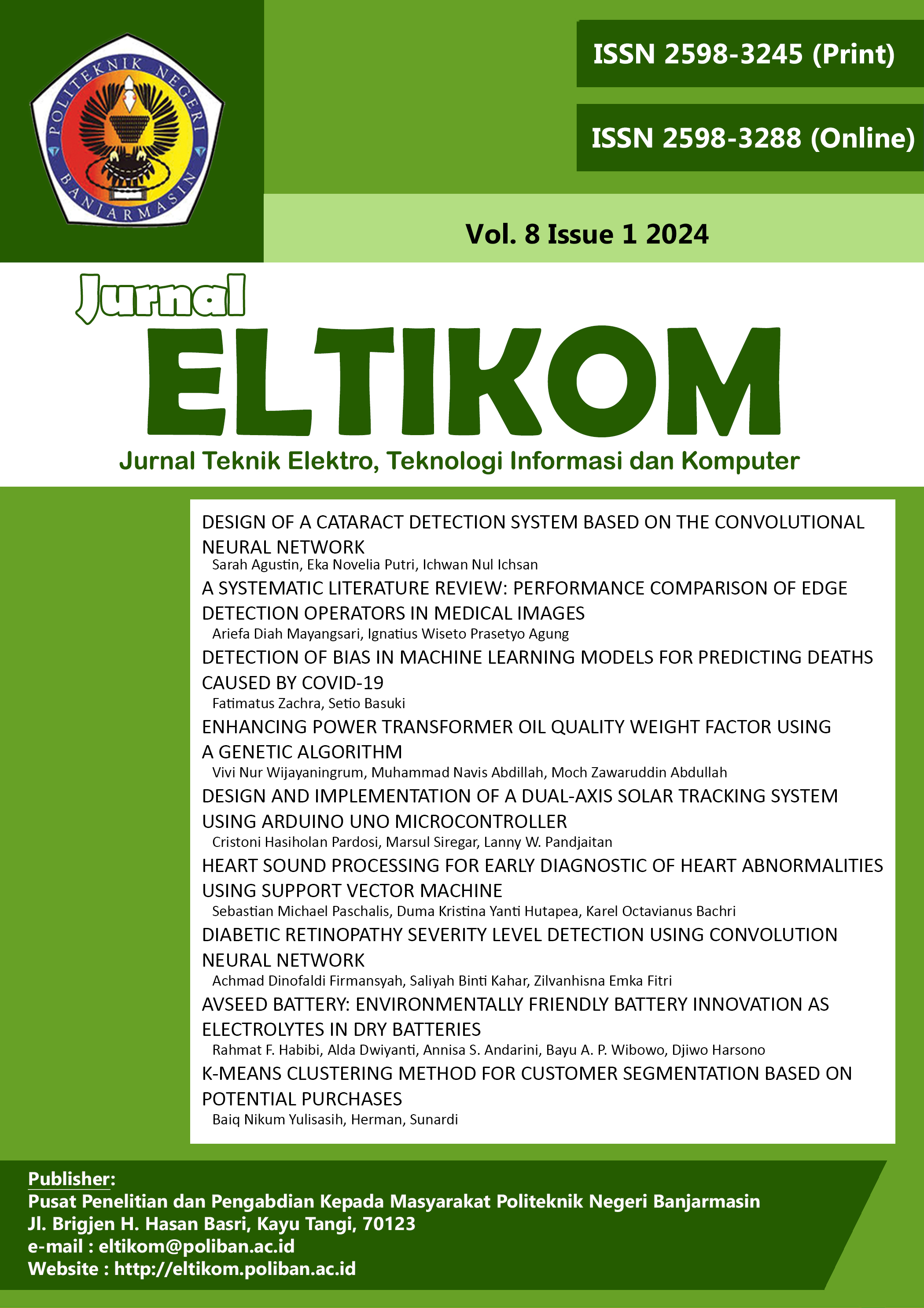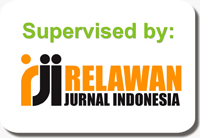Enhancing Power Transformer Oil Quality Weight Factor using A Genetic Algorithm
DOI:
https://doi.org/10.31961/eltikom.v8i1.1052Keywords:
electricity, insulating oil, optimization, power systemAbstract
Power transformers are critical to electrical power systems but are prone to failures due to factors such as heat, electricity, chemical reactions, mechanical stress, and adverse environmental conditions. Moni-toring the insulating oil effectively is key to preventing these failures. A major challenge in this process is determining the optimal weights for the oil quality index, which lacks a standardized benchmark and often relies on subjective expert assessments. To reduce expert bias and subjectivity, this research utilizes a genetic algorithm to optimize the weightings for five essential parameters: color, water content, break-down voltage (BDV), interfacial tension (IFT), and acidity. The algorithm operates through three stages: crossover, mutation, and selection, and analyzes data from 504 oil tests across various transformers. The mean absolute percentage error (MAPE) is used as the fitness value to assess the algorithm's effective-ness. The optimization process determined the best conditions as 132 iterations, a population size of 180, a crossover rate of 0.2, and a mutation rate of 0.8. These parameters achieved an average MAPE of 1.799% over ten trials, indicating high accuracy. This research not only optimizes the weighting of the oil quality index but also significantly reduces the need for expert input and subjective judgments in trans-former maintenance. The findings are expected to improve the efficiency and reliability of power trans-formers, thereby minimizing failures and associated economic costs.
Downloads
References
A. Naderian, P. Pattabi, and L. Lamarre, “Improving the Assessment of Remaining Life of Service Aged Power Transformers,” in 2019 IEEE Electrical Insulation Conference (EIC), 2019, pp. 330–334.
I. Diahovchenko et al., “Mitigation of transformers’ loss of life in power distribution networks with high penetration of electric vehi-cles,” Results in Engineering, vol. 15, p. 100592, Sep. 2022, doi: 10.1016/j.rineng.2022.100592.
W. R. Tamma, R. A. Prasojo, and Suwarno, “High voltage power transformer condition assessment considering the health index value and its decreasing rate,” High Voltage, vol. 6, no. 2, pp. 314–327, Apr. 2021, doi: 10.1049/hve2.12074.
M. Badawi et al., “Reliable Estimation for Health Index of Transformer Oil Based on Novel Combined Predictive Maintenance Tech-niques,” IEEE Access, vol. 10, pp. 25954–25972, 2022, doi: 10.1109/ACCESS.2022.3156102.
A. Dhini, A. Faqih, B. Kusumoputro, I. Surjandari, and A. Kusiak, “Data-driven fault diagnosis of power transformers using dissolved gas analysis (DGA),” International Journal of Technology, vol. 11, no. 2, pp. 388–399, 2020, doi: 10.14716/ijtech.v11i2.3625.
M. E. A. Senoussaoui, M. Brahami, and I. Fofana, “Transformer oil quality assessment using random forest with feature engineering,” Energies (Basel), vol. 14, no. 7, Apr. 2021, doi: 10.3390/en14071809.
B. P. Das and L. Cheim, “Transformer assessment using health index - Part II,” Transformers Magazine, vol. 8, no. 1, pp. 58–64, 2021.
Y. Zhou, L. Ma, J. Yang, and C. Xia, “Entropy Weight Health Index Method of Power Transformer Condition Assessment,” in The Proceedings of 2011 9th International Conference on Reliability, Maintainability and Safety, IEEE, 2011, pp. 426–431.
Y. Zhu, D. Tian, and F. Yan, “Effectiveness of Entropy Weight Method in Decision-Making,” Math Probl Eng, vol. 2020, pp. 1–5, 2020, doi: 10.1155/2020/3564835.
S. Luo and P. Yang, “Design and evaluation of a sustainable entropy-weighted and VIKOR-based method for offshore oil collecting,” Heliyon, vol. 9, no. 11, p. e21256, Nov. 2023, doi: 10.1016/j.heliyon.2023.e21256.
A. D. Sutadian, N. Muttil, A. G. Yilmaz, and B. J. C. Perera, “Using the Analytic Hierarchy Process to identify parameter weights for developing a water quality index,” Ecol Indic, vol. 75, pp. 220–233, Apr. 2017, doi: 10.1016/j.ecolind.2016.12.043.
R. A. Prasojo, A. Setiawan, Suwarno, N. U. Maulidevi, and B. A. Soedjarno, “Development of Analytic Hierarchy Process Technique in Determining Weighting Factor for Power Transformer Health Index,” in 2019 2nd International Conference on High Voltage Engi-neering and Power Systems (ICHVEPS), 2019, pp. 1–5.
A. V. Lubentsov, V. N. Bobrov, D. B. Desytov, and A. N. Noev, “The advantage of the method of hierarchy analysis, the statistical methods of decision support,” in Journal of Physics: Conference Series, Institute of Physics Publishing, Apr. 2019, p. 012079. doi: 10.1088/1742-6596/1203/1/012079.
K. Varpa, K. Iltanen, and M. Juhola, “Genetic Algorithm Based Approach in Attribute Weighting for a Medical Data Set,” Journal of Computational Medicine, pp. 1–11, Sep. 2014, doi: 10.1155/2014/526801.
V. N. Wijayaningrum and W. F. Mahmudy, “Fodder composition optimization using modified genetic algorithm,” Indonesian Journal of Electrical Engineering and Informatics (IJEEI), vol. 7, no. 1, pp. 67–74, 2019, doi: 10.11591/ijeei.v7i1.461.
S. Katoch, S. S. Chauhan, and V. Kumar, “A review on genetic algorithm: past, present, and future,” Multimed Tools Appl, vol. 80, no. 5, pp. 8091–8126, Feb. 2021, doi: 10.1007/s11042-020-10139-6.
D. Rediansyah, R. A. Prasojo, Suwarno, and A. Abu-Siada, “Artificial intelligence-based power transformer health index for handling data uncertainty,” IEEE Access, vol. 9, pp. 150637–150648, 2021, doi: 10.1109/ACCESS.2021.3125379.
W. R. Tamma, R. A. Prasojo, and Suwarno, “High voltage power transformer condition assessment considering the health index value and its decreasing rate,” High Voltage, vol. 6, no. 2, pp. 314–327, 2021, doi: 10.1049/hve2.12074.
Z.-D. Xu, Y.-Q. Guo, J.-T. Zhu, and F.-H. Xu, “Intelligent Control Strategies,” in Intelligent Vibration Control in Civil Engineering Structures, Elsevier, 2017, pp. 21–61. doi: 10.1016/b978-0-12-405874-3.00002-3.
R. A. Pambudi, W. Lubis, F. R. Saputra, H. P. Maulidina, and V. N. Wijayaningrum, “Genetic Algorithm for Teaching Distribution based on Lecturers’ Expertise,” Kinetik: Game Technology, Information System, Computer Network, Computing, Electronics, and Control, vol. 4, no. 4, pp. 297–304, 2019, doi: 10.22219/kinetik.v4i4.859.
V. N. Wijayaningrum, Konsep dan Penerapan Algoritma Genetika. Banda Aceh: Syiah Kuala University Press, 2021.
E. Wirsansky, Hands-On Genetic Algorithms with Python. Packt Publishing, 2020.
V. N. Wijayaningrum, W. F. Mahmudy, and M. H. Natsir, “Optimization of Poultry Feed Composition using Hybrid Adaptive Genetic Algorithm and Simulated Annealing,” Journal of Telecommunication, Electronic and Computer Engineering, vol. 9, no. 2–8, pp. 183–187, 2017.
H. Du, Z. Wang, W. Zhan, and J. Guo, “Elitism and distance strategy for selection of evolutionary algorithms,” IEEE Access, vol. 6, pp. 44531–44541, Aug. 2018, doi: 10.1109/ACCESS.2018.2861760.
K. Kalaiselvi and A. Kumar, “An empirical study on effect of variations in the population size and generations of genetic algorithms in cryptography,” in 2017 IEEE International Conference on Current Trends in Advanced Computing (ICCTAC), 2017, pp. 1–5.
J. J. M. Moreno, A. P. Pol, A. S. Abad, and B. C. Blasco, “Using the R-MAPE index as a resistant measure of forecast accuracy,” Psico-thema, vol. 25, no. 4, pp. 500–506, 2013, doi: 10.7334/psicothema2013.23.
M. I. Ananda, “Model Analysis of Gated Recurrent Unit for Multivariate Rice Price Forecasting,” Jurnal ELTIKOM: Jurnal Teknik Elektro, Teknologi Informasi dan Komputer, vol. 7, no. 2, pp. 125–132, 2023, doi: 10.31961/eltikom.v7i2.770.
Downloads
Published
How to Cite
Issue
Section
License
Copyright (c) 2024 Jurnal ELTIKOM : Jurnal Teknik Elektro, Teknologi Informasi dan Komputer

This work is licensed under a Creative Commons Attribution-NoDerivatives 4.0 International License.
All accepted papers will be published under a Creative Commons Attribution 4.0 International (CC BY 4.0) License. Authors retain copyright and grant the journal right of first publication. CC-BY Licenced means lets others to Share (copy and redistribute the material in any medium or format) and Adapt (remix, transform, and build upon the material for any purpose, even commercially).




